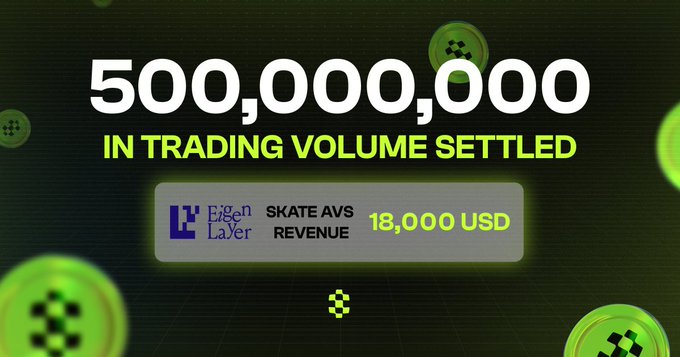Skate AVS has demonstrated significant growth in their verifiable infrastructure platform:
- Over $500M in total settlements
- Generated $18K+ in AVS fees
- Substantial increase from May's $90M trading volume
- Successful implementation of real yield distribution to Ethereum restakers
The platform continues to strengthen the EigenLayer ecosystem through:
- Protocol fee generation
- Strategic buybacks
- Enhanced operator alignment
- Phased slashing implementation
- Cross-chain AMM functionality across ETH, Sui, Solana, and Aptos
This growth validates the effectiveness of verifiable infrastructure in creating sustainable value loops within the ecosystem.
$500M+ settled. $18K+ in AVS fees. This is the flywheel: Usage → volume → fees → alignment. @skate_chain is proving what verifiable infra can do.
With $500M in trading volume settled, Skate AMM has generated over $18K in fees for Skate’s @eigenlayer AVS. It only goes higher from here.
EigenLayer: Revolutionizing ETH Restaking
EigenLayer introduces multi-protocol ETH restaking, allowing users to secure multiple protocols simultaneously with the same staked ETH. This innovation: - Enhances capital efficiency across the Ethereum ecosystem - Creates new revenue streams through protocol fees - Enables collaboration between restakers, operators, and developers The platform aims to strengthen network security while reducing operational costs. This architecture supports future scalability and promotes broader adoption of decentralized applications.
Weekly Verifiable Stack Updates - Eigen Times Report
Major developments across the verifiable technology ecosystem this week: - Active Validator Sets (AVSs) show significant scaling progress - New AI-crypto integration tools released - Fresh application primitives deployed - Multiple testnet activities intensifying - Enhanced coordination mechanisms implemented The ecosystem demonstrates steady maturation with practical verifiability features now operational rather than theoretical. These updates signal continued momentum in infrastructure development and real-world applications. *Credit: @satyaki44*
EigenLayer's OB-1 AI Debugger and Studio Launch Transform AVS Development
OpenBlock Labs has demonstrated their AI tool OB-1's capability to debug EigenLayer infrastructure autonomously in just 10 minutes. This breakthrough coincides with the launch of EigenLayer Studio, an AI-powered development environment. Key updates: - OB-1: Automated debugging with zero human intervention - EigenLayer Studio: New AI-powered testing playground - Simplified AVS development for all skill levels - Verifiable cloud accessibility improvements Try EigenLayer Studio: [studio.eigenlayer.xyz](http://studio.eigenlayer.xyz) *This marks a significant step toward streamlining blockchain infrastructure development.*
Polymarket and UMA Protocol Collaborate on Next-Gen Prediction Market Oracle
Polymarket continues its impressive growth trajectory with significant milestones in recent months: - Nearly $400M in trading volume recorded in July - Over 65,000 new user accounts created - Strategic collaboration with UMA Protocol and EigenLayer announced The partnership focuses on developing an advanced oracle system for real-world prediction markets. This initiative aims to enhance market reliability and data verification capabilities. The collaboration represents a significant step toward mainstream adoption of prediction markets, combining Polymarket's platform reach with UMA's Optimistic Oracle technology. Learn more: [UMA's detailed blog post](https://blog.uma.xyz/articles/uma-polymarket-and-eigenlayer-research-a-next-gen-prediction-market-oracle)
EigenLayer Launches Multi-Protocol Restaking on Ethereum
EigenLayer has introduced a groundbreaking multi-protocol restaking system for Ethereum, allowing users to restake their ETH across multiple protocols simultaneously. The platform enables: - Enhanced cryptoeconomic security beyond core Ethereum - New revenue streams through protocol fees - Improved capital efficiency - Reduced operational costs The ecosystem connects restakers, operators, and developers in a collaborative model, fostering network resilience and adaptability. This infrastructure supports future decentralized applications while maintaining network security.
